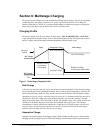
Charging Profile
60 Prosine 2.5/3.0 Installation & Operation Guide
limit, based on battery size settings, charging moves on to the next stage. For flooded batteries, the
absorption charge is maintained for approximately one more hour. The absorption charge stage
restores the remaining 25% of the battery’s charge.
Float Charge
The float charge is a maintenance mode in which the output voltage of the Prosine inverter/charger is
reduced to a lower level, typically about 13.5 volts, (27 volts for 24V models) to maintain the battery's
charge without losing electrolyte through gassing. Unlike many stand-alone chargers, the Prosine
inverter/charger can be left connected to your battery indefinitely without risk of overcharging. When
DC loads are placed on the battery, the charger will deliver currents up to the Maximum Charge Rate
setting while maintaining the float voltage.
Equalization Charge
The fourth charging step, known as the equalization charge, is manually initiated because it is not
required every time the battery is recharged. Equalization is a deliberate overcharge of the battery.
Equalizing your batteries will reduce sulfation and help reach and maintain the peak capacity of the
battery.
During normal charging, temperature and chemical imbalances prevent some cells from reaching full
charge. These reduced capacity cells accelerate sulfation (the build up of lead sulfate on the battery
plates) and decrease the ampere-hour capacity of the battery. During equalization, the battery is
intentionally held above the gassing voltage. Fully charged cells dissipate the charging energy by
gassing while incompletely charged cells continue to charge. The rapid gassing that occurs during
equalization also helps to recondition the battery. The gassing creates a stirring action which reverses
electrolyte stratification (the separation of the liquid electrolyte into layers of different acid
concentrations). The stirring action also helps to break up any lead sulfate which may remain after
normal charging.
An equalization charge should only be performed on vented, flooded (non-sealed or "wet") batteries
and only as often as recommended by the battery manufacturer. The battery section of this manual
provides further information on battery types and their charging characteristics. Refer to “Operation in
Equalization Mode‚” on page 61 for further details.


















